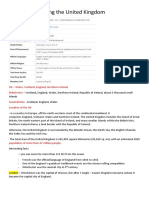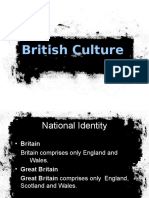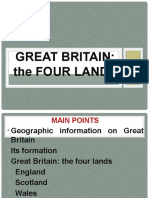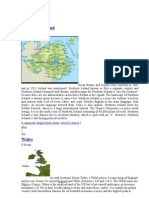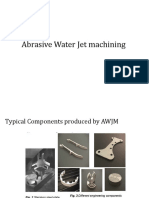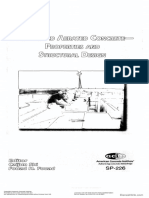0% found this document useful (0 votes)
10 views68 pagesGroup 1 - British Culture
Lecture
Uploaded by
duongmyphuonganh10012005Copyright
© © All Rights Reserved
We take content rights seriously. If you suspect this is your content, claim it here.
Available Formats
Download as PDF, TXT or read online on Scribd
0% found this document useful (0 votes)
10 views68 pagesGroup 1 - British Culture
Lecture
Uploaded by
duongmyphuonganh10012005Copyright
© © All Rights Reserved
We take content rights seriously. If you suspect this is your content, claim it here.
Available Formats
Download as PDF, TXT or read online on Scribd
/ 68
Group 1 - The United Kingdom
Dương Mỹ Phương Anh (leader) - Introduction
Đỗ Phạm Thùy Dương - The United Kingdom
Đỗ Thúy Diệu - The United Kingdom (Cont’d) +
England (Part 1)
Nguyễn Thị Hoàng Anh - England (Part 2)
Hoàng Tuệ An - Wales
Nguyễn Thị Kim Chi - Scotland + Northern
Ireland
-The United Kingdom is officially called The
United Kingdom of Great Britain and Northern
Ireland, also know as Britain or just The UK.
-The United Kingdom is situated off the North-
Geographical Western coast of continental Europe.
location -It’s surrounded by the North Sea. The English
Channel, The Irish Sea and the Atlantic Ocean.
-It only has a land border with the Republic of
Ireland
The Channel Tunnel under the English channel links
England and France.
The Four Constituents countries:
-The UK has 4 constituent parts: England, Wales and Scotland are on the island
of Great Britain, Northern Ireland is on the island of Ireland.
England - The capital is London. Scotland - The capital is Edinburgh.
-England, Scotland and Wales together form Great Britain.
-There are also comprise numerous small islands: Isle of
Wight, Anglesey, Scilly, Orkney, Shetland and the Hebrides.
The capital is Cardiff. The capital is Belfast.
Distinction Between The UK- Great Britain and
Northern Ireland:
TERM INCLUDE TYPES
England, Scotland, Wales,
UK Political entity
Northern Ireland
England, Scotland, Wales
GREAT BRITAIN Geographical region
Part of the UK, not part of Region/country within
NORTHERN IRELAND
Great Britain the UK
The UK:
-The UK is a sovereign state comprising four constituent countries. While the
central government is based in Westminster, London, Scotland, Wales, and
Northern Ireland each have devolved governments with distinct legislative powers.
- Include: England, Scotland, Wale, Northern Ireland.
Great Britain:
-Great Britain refers to the largest island within the British Isles, excluding Northern
Ireland
-Include: England, Scotland, Wale.
Nothern Ireland
-Part of the island of Ireland (along with the Republic of Ireland).
-It is part of the United Kingdom, but not of Great Britain.
-Northern Ireland has its own parliament and distinct political identity. There are
ongoing cultural and political sensitivities regarding its status.
- Apart from geographical differences, these regions also have different cultural
characteristics, the most basic of which is the difference between their flags.
The Commonwealth
56 members, 2.7 billion people
(2025).
Former British Empire countries.
Purpose: promote cultural, economic
& political cooperation.
South Africa: left (1960s, apartheid)
→ rejoined (1994).
Canada, Australia, NZ: still recognize
British Queen as Head of State.
Queen = symbolic Head (some want
elected leader).
Common Activities
Commonwealth Games (every 4 years).
Common Activities
Commonwealth Day (March).
Common Activities
CHOGM (leaders’ meeting, every 2 years)
Common Activities
Youth & Education (scholarships, exchanges)
Common Activities
Cultural exchanges (arts, law, health, media)
Role & Influence
Maintains global connections, democracy,
education, and development.
England: strong influence on law, language, culture,
politics.
Geography
Largest country in UK,
south of Great Britain
Borders: Scotland (N),
Wales (W)
35 km from France via
Channel Tunnel
History
Named after Angles (5th century)
United under King Athelstan (937)
Norman Conquest (1066)
Union with Scotland
(1707), Ireland (1800)
→ now only N. Ireland
in UK
Landscape
Low hills & plains, pastures, meadows
Pennines = “backbone
of England”
Highest point: Scafell
Pike (978m)
Population
Population: ~50 million
Capital: London; major cities: Birmingham,
Manchester, Liverpool, Leeds, Sheffield
Language: English | Currency: Pound sterling (£)
Climate
Rarely below freezing in winter (coldest: Jan–
Feb)
Rarely above 32°C (90°F) in summer
Seasons:
🌸
1. Spring: Mar–May
☀️
2. Summer: Jun–Aug
🍂
3. Autumn: Sep–Nov
❄️
4. Winter: Dec–Feb
London is the capital city of both England
and the United Kingdom
London is in the south-east of England. It
is a very old city that has a very long
history all the way back to ancient Roman
times.
Major cities in England include:
London, Birmingham, Manchester, Leeds,
Sheffield and Liverpool
London is a vast metropolitan area and a global
capital of financial, fashion, and culture.
Big Ben Buckingham Palace London Eye
Birmingham, the UK's second largest city, is located in the
industrial heartland.
Considered Britain's "second city," it is a cultural, sporting,
entertainment, shopping, and media hub.
The Bullring Shopping Center
Bristol, the largest city in South England (after
London), vibrant music scene, lovely historic
buildings, and an attractive waterfront.
Clifton Suspension Bridge SS Great Britain
Brighton – Victorian seaside resort turned into one of the
major nightlife entries of Europe.
Liverpool – famed nautical city and home of the Beatles.
(European Capital of Culture 2008).
London is a vast metropolitan area and a global capital of
financial, fashion, and culture.
Manchester United Manchester City
Newcastle upon Tyne – a thriving northern city with world-famous
nightlife.
Nottingham – home of Robin Hood (a legendary heroic outlaw)
and Nottingham Castle.
York – ancient capital of Yorkshire, with Roman, Viking
and Mediaeval remains.
Birthplace of English language
Famous writers: Shakespeare, Dickens
William Shakespeare Charles Dickens
Afternoon tea Bonfire Night
Pub culture Changing of the Guard
the Tudor roses (red, white)
The Beatles Adele London’s West End
Traditional dishes: Fish & chips, roast beef, full English
breakfast.
National drink: Tea.
Sports are a huge part of English culture. England is the
birthplace of football, cricket, and rugby.
A country that is part of the United Kingdom
Capital city: Cardiff
2021: 3.2 million
The Western side of Great Britain
Area: 20,779 km2
Border: England, Bristol Channel,
Celtic Sea
Highest mountain: Snowdon
Location: north temperate zone,
maritime climate
Celtic Britons + a strong tradition of resistance to English rule
A principality, a country ruled by a prince
“Principality of Wales”, “Prince of Wales”: a political label,
not a reflection of how Wales sees itself
Should be respected as a country in its own right
Welsh (Cymru): a Celtic language from the Brittonic branch
Developed from Common Brittonic around the 6th century
Known for music, poetry, and storytelling
Eisteddfod: celebrates the Welsh language, arts, music, and
culture
Patron Saint: Saint David
Wales Rugby
Wales Football (Gareth Bale)
Real Madrid 2022 World Cup
Scotland is located in the north of Great
Britain, sharing a southern border with
England.
Scotland consists of three main regions:
the Highlands, the Central Belt, and the
Southern Uplands, along with more than
790 islands
Capital: Edinburgh
Largest city: Glasgow
Famous for its clans, kilts, and medieval
castles.
Literature and arts linked to figures such
as Robert Burns (poet and songwriter),
Walter Scott, Robert Louis Stevenson, and
actor Sean Connery.
Major cultural event: the world-renowned
Edinburgh Festival.
Loch Ness is the most famous lake,
associated with the legendary monster
Nessie.
Main languages: English and Scottish
Gaelic.
Language
In Gaelic, Scotland is called Alba.
Currency: Pound Sterling (£) (GBP). Simbols
National flower: Thistle.
Patron saint: St Andrew.
• Area: 13,843 km² (5,459 square miles).
• Population: 1.7 million people.
• Capital and largest city: Belfast.
• Northern Ireland consists of six countries: Antrim,
Down, Armagh, Tyrone, Fermanagh, and Londonderry.
• Created by the Government of Ireland Act (1920),
following the partition of Ireland in 1921.
• Currency: Pound Sterling (£) (GBP).
• Economy is closely linked to the United Kingdom.
• Belfast is the economic and administrative center.
• Agriculture (livestock, crops, dairy) and services play
important roles.
• Shipbuilding, linen production, and
engineering (especially in Belfast).
• Modern industries include manufacturing,
aerospace, food processing, and tourism.
• Major tourist attractions: The Giant’s Causeway
(UNESCO World Heritage site), The Mourne
Mountains, Lough Neagh, The Glens of Antrim,
Fermanagh Lakeland.
Predominantly Christian, with two main traditions:
• Protestants (majority historically, many
identifying as Unionists).
• Catholics (minority historically, many
identifying as Nationalists).
• Religion has historically influenced politics
and society in Northern Ireland.
• Patron saint: St. Patrick.





































